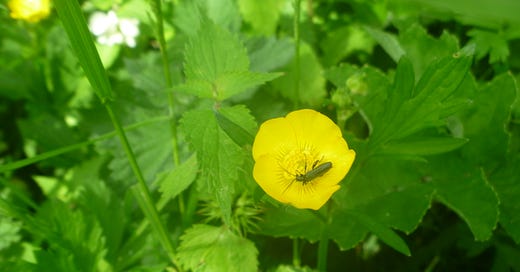Welcome to the second of my posts about 30 Days Wild, the campaign from The Wildlife Trusts that aims to get people more engaged with nature. This week I want to look a bit more at learning about nature.
I would never want to give people the impression that lack of knowledge would mean you can’t enjoy nature. Everyone can get outside and enjoy the beauty of flowers or birdsong. Many people will, however, find that experiencing nature leads naturally to wanting to know more. For example, every time I see an insect that’s umknown to me, I want to find out what it is! I can’t guarantee that I find the answer, but I enjoy trying. When I saw the insect below a few weeks ago, it rang a bell with me, a thick kneed flower beetle? I thought.
I looked up flower beetles on the NatureSpot website (which is an excellent generalist guide to British wildlife, focussed on Leicestershire and Rutland in central England) and found out that the insect is a Swollen Thighed Beetle (Oedemera nobilis). So that’s a new species for me and one that is, apparently, under-recorded in Scotland.
So how do you set about learning more about the aspects of nature that interest you?
At this time of year, in the UK, there’s an excellent TV programme on the BBC. Springwatch is a live show broadcast in the evenings over three weeks, sharing amazing wildlife sightings and some really interesting science in a magazine format that has something for everyone, whatever your level of knowledge about wildlife. It’s a great way to learn more about nature without needing to go to too much effort.
If you want to get more involved, you can join a local group, such as your local branch of the RSPB (Royal Society for the Protection of Birds) or your local naturalists group, such as Edinburgh Natural History Society. Such groups usually offer outings and meetings where you can discover more about wildlife and meet like minded people. There are a good number of online groups that can help you learn about particular groups of plants or animals (I find the Facebook UK Hoverfly Group a very friendly and helpful group). The Scottish Wildlife Trust regularly posts online talks about different aspects of nature, you can catch up with these talks here.
There are a lot of websites that are invaluable for identifying wildlife. I put together a list of the sites that are useful for identifying British wildlife, which you can find on my original Crafty Green Poet blog here. (I still update that blog a couple of times a week, mostly sharing observations of nature and book reviews).
There are also a lot of apps out there to help you identify nature. As I don’t have a smartphone, I’m not very aware of these, except that I’ve heard a lot of people, like Zabby in her recent post below, say that the Merlin app is invaluable for identifying which birds are singing around you.
Of course, identifying wildlife is only one aspect of learning about nature. These days there are lots of books and programmes that give insights into various aspects of nature. For example, I recently finished reading Riddled with Life, by Marlene Zuk, which gives fascinating insights into parasites, not only the organisms that cause illness in humans, but also parasites in wider nature.
If you’re interested in learning more about nature for this year’s 30 Days Wild, you could for example:
Find and identify a species (eg a tree, a bird, an insect) you’ve never identified before;
Learn more about the lifestyle of an animal you’re already familiar with;
Learn about the medicinal uses of a common plant;
Learn to recognise the song of a common bird;
Read one of the many books that looks at interesting aspects of nature.
If you’re a teacher, Eco-Schools Scotland is a good starting point for integrating nature into the curriculum.
Once you learn to identify wildlife, you may want to start recording what you see!
Using your love of nature to help conservation
In previous posts I've talked about butterfly surveying and the wildlife surveys I did a few years ago in Edinburgh's council managed cemeteries. In both cases, the survey results feed into recording wildlife and then further on feed into management decisions relating to how best look after the sites to benefit both nature and people. In this post, I wa…
Recording wildlife is just one of the ways in which you can help wildlife, which will be the next topic for next week’s post!
If you have any tips on how to learn about nature, pop them in the comments!
I’ve Been Away!
We had a lovely few days in and around Perth last week. You can see some of our photos here. I’ll also be sharing more about parts of our trip in next week’s post, which will focus on Helping Nature.
I’ve been Published!
I’m delighted to have three poems in the second volume of North of Oxford's tribute to Russell Streur, former editor of The Camel Saloon and Plum Tree Tavern.
I’m very pleased to also have a poem included in the Ekphrastic Review’s selection of responses to a work by Severine Gallardo. You can see the artwork and read all the responses here.







The naming of things - so very important to know what you are looking at
I like the theme of 30 Days Wild, Juliet. Coincidently, I have recently become interested in heron again. I am going to use the remaining weeks in June to learn more about 3 species of herons I regularly see: Great Blue Heron, Black-crowned Night Heron, and the Green Heron. I find herons fascinating and enjoy simply watching them.